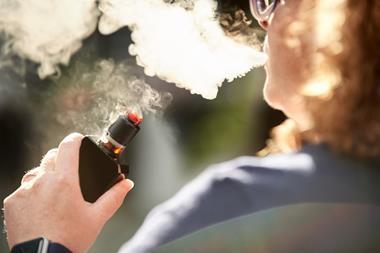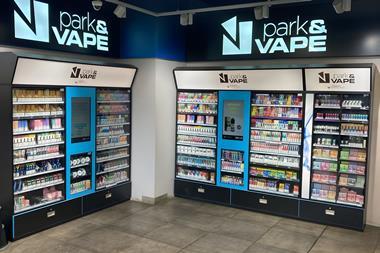April 6 has been and gone and with it went traditional tobacco displays in stores of 3,000sq ft and above. Instead shoppers in the grocery multiples and larger convenience stores across England are met with kiosks with their shutters down over the tobacco products. One quick glance and these kiosks look closed. To counter this, many of the grocery mults have plastered their shutters with large ’We are open’ signs. The problem was, the new law was brought in but someone forgot to tell the smokers!
Of course, it’s still too early to tell what the impact has been on the supermarkets’ tobacco sales. Imperial Tobacco reports that sales volumes have dropped by around 2-3% since the display ban was enforced but it expects sales to return to normal as soon as shoppers and staff become familiar with the situation.
Meanwhile, retailers with smaller stores which will be most forecourts don’t have to comply with the display ban until 2015. Many within the industry believe this represents a massive opportunity for these retailers.
Booker’s sales director for retail Steve Fox reckons it offers the biggest opportunity since the launch of the National Lottery. "We estimate that an extra two million shoppers each week could transfer to independent retailers; bringing with them an extra £1bn of sales. This could result in £140m in extra profits for small stores."
He says the fact that tobacco products are now out of sight in the grocery mults will cause confusion, slow service and out-of-stocks.
All the big tobacco manufacturers agree that now is the time for smaller retailers to raise their game and really focus on meeting their shoppers’ needs.
JTI’s head of communications Jeremy Blackburn says: "Our advice is to maintain full range and availability. It sounds obvious but it’s so important for retailers to monitor and respond to sales at a local level and ensure the basic principles of category management are continuously put into practice."
BAT UK’s head of corporate and regulatory affairs Ian Robertson says that when the display ban is implemented within forecourts in 2015, there will be major issues around stock replenishment and inventory.
"We are providing as much support as we can to help retailers on the ground manage the change in legislation with minimal disruption and ensure that they don’t suffer as a result."
To this end, BAT has created the Guide to the Retail Display Ban in England. "With more than 20,000 copies ordered since the end of March it has proved very popular," says Robertson. "It includes tips and recommendations on best practice inventory management, merchandising and customer service, three areas on which it is crucial to focus to maintain consumer loyalty in the new trading environment."
Plain packaging
On April 16, a 12-week consultation to determine whether tobacco products should be sold in plain packaging was launched by the government.
Imperial Tobacco’s head of convenience Mike Laney says: "Tobacco packaging has never been identified as a reason why people start to smoke or continue to smoke. We oppose the plain packaging of tobacco and will be setting out our detailed views in our response to the government’s Consultation."
There is particular concern about the impact plain packaging will have on illicit trade. "Logic dictates that making all tobacco products available in the same generic packaging will increase the already high level of counterfeit product available in the UK, placing further pressures on retailers and government tax revenues," says Laney.
JTI’s Blackburn adds: "The seriousness of plain packaging, if introduced, cannot be over-stated. Indeed, the mere proposals amount to commercial vandalism: reducing consumer choice; reducing brand switching; and denying suppliers and retailers any real ability to innovate and compete, other than on price." He says the impact on the retail trade is particularly worrying: "Like many other goods, tobacco is offered through a mix of products that provide choice in a range from premium to value.
"Retailers are dependent on having a strong product offering in their store in order to compete, maintain footfall and retain customers. Plain packaging would significantly damage competition in the market by creating an increased focus on price."
BAT’s Ian Robertson, says: "If standardised tobacco packaging happens, what’s next? Alcohol? Fast-food? Already moves towards considering legislation in these sectors are under way. Government controlled packaging is wrong and must be challenged.
"Forecourts will face increased transaction times, complex stock management and higher security risks. The forecourt channel will be more adversely affected by government-controlled packaging than other retailers as most only re-stock the unit once or twice a day when a manager is available. Government-controlled packaging will result in increased out-of-stocks and extra time needed to fill the gantry."
The government’s consultation is open for responses until July 10.
Retailers are encouraged to respond by visiting http://consultations.dh.gov.uk, emailing tobaccopacks@dh.gsi.gov.uk or writing to Tobacco Packs Consultation, Department of Health, 7th Floor, Wellington House, 133-155 Waterloo Road, London SE1 8UG.
Alternatively, tell your MP visit, call, email or write to your MP to tell them how this would impact your business.
To find out who your MP is visit www.writetothem.com or telephone 020 7219 3000.
Forest (Freedom Organisation for the Right to Enjoy Smoking Tobacco) has launched the Hoops (’Hands Off Our Packs’) campaign to give opponents of plain packaging of tobacco a chance to have their say. To find out more and to sign their petition, visit http://www.handsoffourpacks.com/.
Price-marked cigs
Price-marking is prevalent across most product categories nowadays and has been offered on cigarettes for some time. Historically, forecourts have traded well in premium-price cigarettes but cash-strapped smokers are trading down and many are tempted by price-marked packs. And it seems price-marking is working well on some forecourt gantries.
At its Primrose Valley site in Filey, north Yorkshire, tobacco accounts for around 30% of Jos Richardson & Son’s shop sales. Director Joseph Richardson says stocking price-marked packs of cigarettes has led to a 25% increase in tobacco sales and around a 10-15% increase in other shop sales.
All pack sizes/varieties of Lambert & Butler, Richmond, Sterling and Mayfair (ie. 10s, 20s, menthol, superkings) are offered in price-marked packs with no non-pricemarked versions available.
Joseph explains: "Sales were struggling and we decided we needed to do something to generate footfall. We tried price-marking and are still making 8% overall on our tobacco category."
To any other retailers considering the price-marked route, he says: "I would only do it on certain sites. We have five sites. I do price-marked cigs at two sites, on two others I don’t do price-marked at all because they are transient sites. At the fifth one, I have introduced it on selected items."
Miles Harvey, operations director at Park Garage Group, says that in some of their forecourt shops they have Player Blue, Stirling and BAT’s Vogue in price-marked packs and, on occasion, Pall Mall. "It all depends on the deal," he says. "We only get a 5% margin but 5% of something is better than 10% of nothing. We’ve seen a huge decline in the sale of premium brands such as B&H Marlboro Lights. Now it’s all Mayfair and B&H Silver the mid-price and economy brands.
"We put price-marked packs in our convenience outlets because you have to reflect value and treat tobacco in the same way as other categories. We get good sales of price-marked cigarettes in some outlets. They work particularly well in low demographic areas where there are a lot of smokers.
"These people would not buy their tobacco from us if we didn’t offer price-marking. We really leave it to the managers to decide whether they want to offer them or not price-marking is a weapon in their arsenal."
But David Cox from Saintfield Road Service Station in Lisburn, Co Antrim stopped selling price-marked cigs about four years ago. He explains: "I was only getting a profit margin of around 5%.
"I now premium price cigs and get around 10%. Sales have not been affected very much. Although I don’t have exact figures, I didn’t notice any great drop in sales after the change."
He says another advantage of having non-price-marked packs was that in the March Budget when the prices rocketed he was able to put the price up on the old stock. "I always try to stock up before the Budget or manufacturers’ price increases," he says.
"Each retailer is different. I’m a member of Spar, which has three price bands depending on the type of store supermarket, neighbourhood or express. I keep the shop at neighbourhood prices and cigs and confectionery at express prices. Some retailers may want to have cheap cigs and express groceries."
Value seekers
Imperial’s Laney says continual tobacco taxation increases and the tough economic conditions are driving the ’value-seeking’ trend among tobacco shoppers.
"More consumers are looking to save money while retaining a desire for quality. Forecourt retailers should recognise the commercial opportunities offered by providing a good range of price-marked brands as tobacco shoppers expect value for money.
"Tobacco is a destination purchase for adult smokers and price-marked packs provide a striking on-shelf presence for retailers to highlight their value to those 12 million UK adults who choose to smoke."
He says retailers need to remember that tobacco shoppers visit stores more frequently than non-smokers and spend twice as much as the average convenience store shopper each year (Him CTP 2011) so providing the right products at the right price is vital.
"Evidence suggests that consumers will shop in outlets that offer a good range of price-marked packs in preference to those that do not as they offer reassurance of value when viewed on-shelf. Retailers could lose tobacco sales, and the impulse purchases made with them, if they do not realise the commercial value provided by price-marked packs.
"Products supported by price-marked packs are offering value to tobacco shoppers and retailers can utilise them to increase their footfall and protect their turnover. This is vital as many smokers are turning to the cheap, poor quality brands offered for sale by criminals in the illicit trade."
BRAND NEWS
l Imperial Tobacco recently added two new lines to its Lambert & Butler range: Fresh Burst and Profile. Fresh Burst gives smokers the opportunity to squeeze a capsule in the filter to release a fresh burst of flavour. Profile is a new streamlined cigarette. Designed for the busy smoker, it is the same length as Lambert & Butler king size but smaller in diameter resulting in a lower price. Lambert & Butler Fresh Burst’s recommended retail price (rrp) is £6.97 for 20 king size. The rrp for Lambert & Butler Profile king size 20s is £6.87. Price-marked packs are also available at £6.50 for Profile king size 20s and £6.60 for Lambert & Butler Fresh Burst king size 20s.
l JTI is introducing a new limited edition pack design for its premium cigarette brand Camel. Inspired by the summer, the new pack comes in three colour variants red, yellow and green. The new designs are being rolled out nationally across Camel Blue 20s from this month and will be available for just two months. Camel is the sixth biggest-selling cigarette brand in the world (Euromonitor 2010), selling more than 8.3 million packs every year in the UK. (JTI estimates 2011).
l The Scandinavian Tobacco Group United Kingdom (ST Group UK) has announced the widespread launch of Moments, its new range of miniature cigars that capitalise on the rapidly growing consumer demand for value-for-money products. The roll-out follows successful trials in the grocery multiples and the cigars are now available in cash and carries nationwide. There are three variants: blue, original and aromatic; packaged in crush-proof tins of 10. Rrp is £3.31.
l JTI is introducing a new premium look pack for B&H Silver Slide. The new pack features a modernised design, including a textured feel and contemporary foil finish. Rrp is £6.93.
tobacco sales tips
l It’s vital that the tobacco gantry remains well stocked and organised. Out-of-stocks should be avoided at all times as this can lead to lost sales, including associated purchases such as soft drinks and newspapers, as well as the potential loss of custom permanently as customers choose to shop elsewhere.
l Ensure top-selling tobacco brands are well stocked and you provide enough facings for them on the gantry.
l Re-stock the tobacco gantry prior to peak trading times.
l Keep up-to-date with local and regional market trends among adult smokers, as well as the latest developments in the tobacco category and ensure your range reflects these. For example, value cigarettes represent the fastest-growing tobacco sector in the UK so forecourt retailers should stock up on brands such as Sterling the UK’s number-one value cigarette.
l Speak to your local tobacco representative for advice on merchandising, market trends, new developments and best sellers.
Source: JTI
Remember to accessorise
Mark Alldred, marketing manager at Republic Technologies UK, says forecourt operators should look upon roll your own (RYO) accessories as a key sales opportunity.
Some larger forecourt stores are already subject to the tobacco display ban. Alldred is urging these retailers to use accessories such as paper and filters to ’signpost the category’ and to help shoppers adjust to the change.
"Larger forecourts are understandably giving more thought to merchandising RYO accessories.
"This should accelerate growth and profit opportunities as RYO accessories is already a high-margin, fast-growing category that forecourts should look to capitalise on."
Meanwhile, value, convenience and flavours remain key drivers of the RYO market, so Republic Technologies offers multipacks and combi-packs for its Swan range.
"When times are hard, cost-conscious shoppers look to make savings on regular purchases such as tobacco and accessories.
"Combi-packs, which combine filter tips with rolling papers, are perceived to offer better value. They’re convenient and all Swan branded combi packs offer a margin of 50% or more. The latest statistics show that sales of this segment are up 48.6% (Nielsen) compelling evidence to stock them," adds Alldred.
Swan combi packs have already been listed by several national forecourt chains, and he says initial sales have exceeded forecasts.
Another trend is down-trading in the cigarette segment and also across from cigarettes to RYO tobacco.
In terms of statistics, RYO tobacco is in growth, up 12.1%.
Filter Tips are up 12.4% while menthol filters are up 24.5%. Multipacks of rolling papers are also up 56.8% (all Nielsen figures).
"Looking at the sales figures, it’s clear that multipacks and category-boosting lines like combi packs are a must-have for forecourts looking to capitalise on the trend for value," adds Alldred.
When it comes to papers, green (corner cut) account for 60% of the category, but many forecourts lose out by neglecting the other 40% of the market.
Alldred says the key to maximising the RYO accessories category is to offer smokers a choice of both brands and weights of paper.
Lighter weight papers, for example, like Swan Ultra Fine (silver) are showing category growth of 29.1%.
"Forecourts should ensure that they stock the key lines and volume sellers in the category.
"The fixture should be signposted with key brands, such as Swan and Zig-Zag.
"There is a temptation to reduce the number of requisites, including rolling papers and filter tips, for new cigarette and RYO tobacco lines.
"However, forecourt retailers need to understand that choice in brands and price is important in growing one of the most profitable categories they sell with a profit on return of over 50%.
"Accessories is a fast-growing section and giving it its own area alongside the tobacco gantry will help to encourage linked purchases and maximise the category."
Don’t forget cigars
l Although cigars sell in smaller volumes than cigarettes, the cigar category is currently worth more than £250m in the UK.
l There are plenty of cigar sales opportunities, which can peak during key seasonal occasions, particularly around the summer and festive periods.
l Remember that some people smoke both cigars and cigarettes.
l It’s crucial to stock the best-selling cigars, which include Café Crème Blue, Café Crème, Hamlet, Hamlet Miniatures and Henri Wintermans Half Corona.
l Stock a range of products from the three main cigar segments: miniatures (Café Crème Blue), smalls (Café Crème Grande) and medium/large (Henri Wintermans Half Corona).
l Make sure that you stock a balanced assortment of quality imported cigars as they stimulate the tobacco category and drive incremental sales and impulse purchases.
l Understand your customers. They know what they want, it’s up to you to stock it.
l Value-for-money cigars such as Moments are growing in popularity, so stock up on a range that meets the needs of cash-conscious customers.
l Don’t forget new products and limited editions, which can reinvigorate this established category.
Source: STG






























No comments yet